Viết về món ăn yêu thích bằng tiếng Anh là một chủ đề phổ biến không chỉ trong học tập mà còn trong giao tiếp hàng ngày. Bài viết này sẽ hướng dẫn chi tiết cách viết đoạn văn nói về Món ăn yêu thích bằng tiếng Anh với nhiều mẫu câu, từ vựng phong phú và cấu trúc đa dạng phù hợp với mọi trình độ.

Nội dung chính
- 1. Cách viết đoạn văn nói về món ăn yêu thích bằng tiếng Anh dễ hiểu
- 1.1 Hướng dẫn từng bước viết đoạn văn đơn giản, đúng ngữ pháp
- 1.2 Gợi ý độ dài phù hợp theo trình độ (Beginner – Intermediate – Advanced)
- 🎯 Bạn muốn con học tiếng Anh như ngôn ngữ mẹ đẻ?
- 2. Từ vựng tiếng Anh miêu tả món ăn yêu thích (có ví dụ thực tế)
- 2.1 Từ vựng về nguyên liệu, hương vị, cách chế biến
- 2.2 Collocations thường gặp (e.g., spicy taste, crunchy texture…)
- 2.3 Idioms và thành ngữ thú vị liên quan đến đồ ăn
- 3. Cấu trúc câu thường dùng khi nói về món ăn bằng tiếng Anh
- 3.1 Cấu trúc giới thiệu món ăn (My favorite dish is…)
- 3.2 Cách diễn đạt hương vị (It tastes/smells like…)
- 3.3 Mẫu câu thể hiện cảm xúc và lý do yêu thích
- 4. Dàn ý viết đoạn văn về món ăn yêu thích theo 3 cấp độ
- 4.1 Cấp độ A1–A2: Ngắn gọn, dễ hiểu
- 4.2 Cấp độ B1–B2: Có thêm lý do & cảm xúc
- 4.3 Cấp độ C1 trở lên: Có kỷ niệm và mở rộng sáng tạo
- 5. Mẫu đoạn văn nói về món ăn yêu thích bằng tiếng Anh theo chủ đề
- 5.1 Món ăn truyền thống Việt Nam (phở, bún chả, bánh mì…)
- 5.2 Món ăn nhanh (pizza, hamburger, fried chicken…)
- 5.3 Món tráng miệng (chè, kem, bánh ngọt…)
- 6. TỔNG KẾT
1. Cách viết đoạn văn nói về món ăn yêu thích bằng tiếng Anh dễ hiểu
Để viết một đoạn văn về món ăn yêu thích bằng tiếng Anh một cách dễ hiểu và thu hút, bạn cần nắm vững một số nguyên tắc cơ bản. Đoạn văn về món ăn không chỉ đơn thuần là miêu tả hương vị, mà còn là cách bạn truyền tải cảm xúc và kỷ niệm gắn liền với món ăn đó.
1.1 Hướng dẫn từng bước viết đoạn văn đơn giản, đúng ngữ pháp

- Bắt đầu với câu mở đầu rõ ràng: Giới thiệu món ăn yêu thích của bạn ngay từ đầu.
My favorite dish is Vietnamese pho, a traditional beef noodle soup from Northern Vietnam. - Mô tả món ăn: Nêu chi tiết về thành phần, hình dáng, màu sắc.
This dish consists of a flavorful broth made by simmering beef bones for hours, flat rice noodles, and thinly sliced beef, topped with fresh herbs like basil and cilantro. - Miêu tả hương vị: Sử dụng các tính từ mô tả hương vị đặc trưng.
The broth has a rich and aromatic flavor with hints of star anise and cinnamon, while the combination of fresh herbs creates a refreshing taste. - Nêu lý do yêu thích: Giải thích vì sao bạn đặc biệt thích món ăn này.
I particularly love pho because it reminds me of chilly winter mornings in Hanoi, where my grandmother would prepare this comforting dish for the whole family. - Kết luận đoạn văn: Tóm tắt cảm nhận và khẳng định lại sở thích.
Whenever I enjoy a bowl of pho, I’m transported back to those precious family moments, which is why it will always remain my favorite dish.
1.2 Gợi ý độ dài phù hợp theo trình độ (Beginner – Intermediate – Advanced)
1. Trình độ Beginner (A1-A2): 50-80 từ
- Sử dụng cấu trúc câu đơn giản
- Từ vựng cơ bản
- Tập trung vào miêu tả đơn giản về món ăn và lý do thích
2. Trình độ Intermediate (B1-B2): 100-150 từ
- Kết hợp câu đơn và câu phức
- Sử dụng từ vựng đa dạng hơn
- Thêm chi tiết về nguyên liệu, cách chế biến
- Bổ sung cảm xúc và kỷ niệm liên quan
3. Trình độ Advanced (C1-C2): 180-250 từ
- Cấu trúc câu phức tạp
- Từ vựng phong phú, idioms và collocations
- Phân tích chi tiết về văn hóa ẩm thực
- Liên hệ món ăn với trải nghiệm cá nhân sâu sắc
- Thể hiện quan điểm và suy nghĩ mang tính triết lý
🎯 Bạn muốn con học tiếng Anh như ngôn ngữ mẹ đẻ?
BMyC đã giúp hàng ngàn phụ huynh như bạn xây dựng thói quen học tập tại nhà hiệu quả.
Hãy để chúng tôi đồng hành cùng bạn và con!
2. Từ vựng tiếng Anh miêu tả món ăn yêu thích (có ví dụ thực tế)
Một đoạn văn nói về món ăn yêu thích bằng tiếng Anh sẽ trở nên sinh động và hấp dẫn hơn khi bạn sử dụng từ vựng phong phú và chính xác. Theo nghiên cứu của Đại học Oxford, một người học tiếng Anh cần nắm vững khoảng 2000-3000 từ vựng để có thể giao tiếp thành thạo trong các tình huống hàng ngày, trong đó từ vựng về ẩm thực chiếm một phần không nhỏ.
2.1 Từ vựng về nguyên liệu, hương vị, cách chế biến
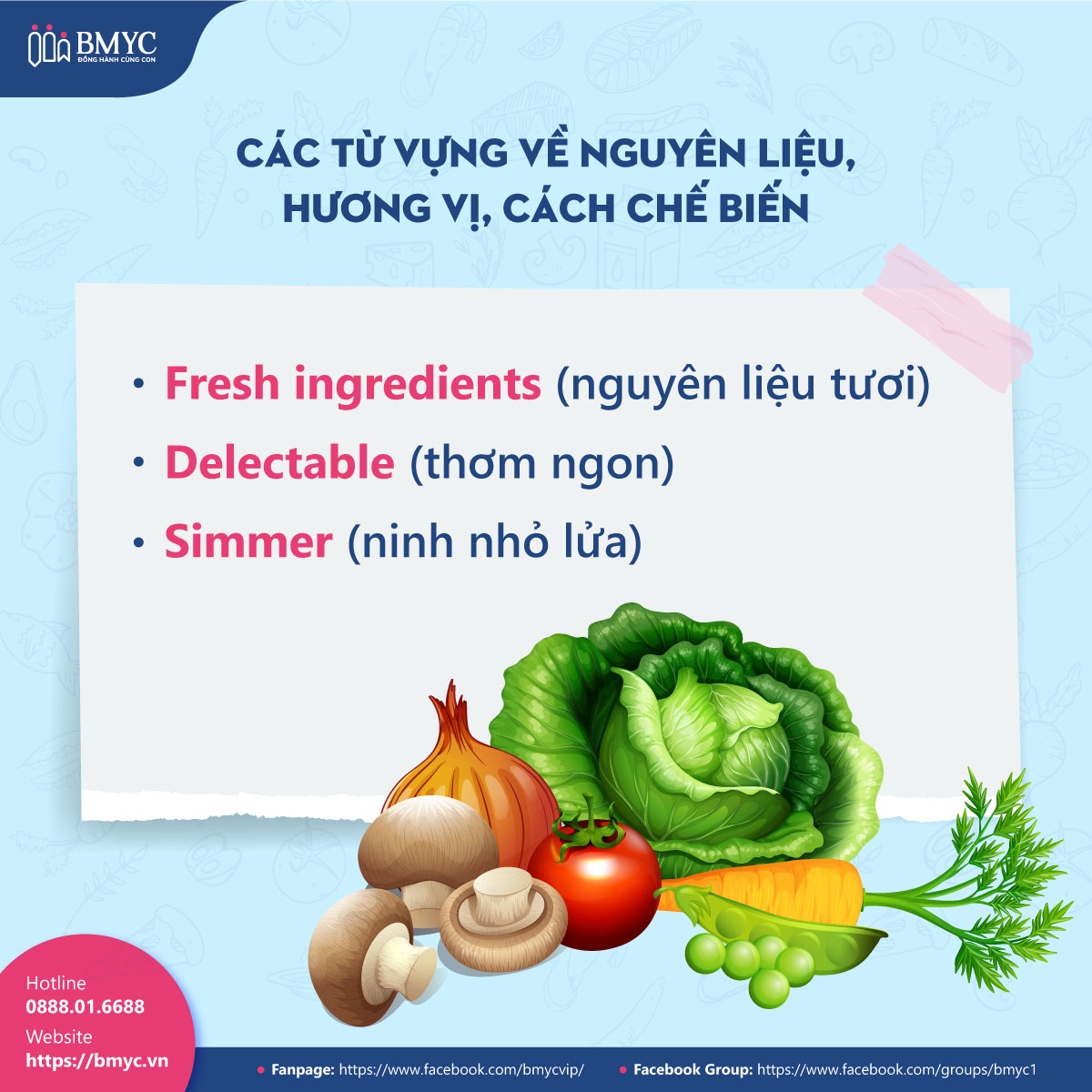
Nguyên liệu:
- Fresh ingredients (nguyên liệu tươi): “This salad is made with fresh ingredients from the local market.”
- Main component (thành phần chính): “Rice is the main component of many Asian dishes.”
- Essential elements (yếu tố thiết yếu): “Lemongrass and galangal are essential elements in authentic Tom Yum soup.”
- Seasonal produce (sản phẩm theo mùa): “The chef only uses seasonal produce to ensure the best flavor.”
- Quality products (sản phẩm chất lượng): “The pasta is made from high-quality products imported from Italy.”
Hương vị:
- Delectable (thơm ngon): “The cake has a delectable sweetness that isn’t overwhelming.”
- Savory (đậm đà): “I prefer savory dishes like lasagna over sweet ones.”
- Tangy (chua nhẹ): “The tangy lemon sauce complements the fish perfectly.”
- Pungent (nồng): “Durian has a pungent smell but a delicious taste.”
- Zesty (đậm đà, có hương vị cay nhẹ): “The zesty orange dressing makes this salad unique.”
- Aromatic (thơm): “The aromatic spices filled the kitchen as the curry simmered.”
- Subtle (tinh tế): “There’s a subtle hint of rosemary in this roast chicken.”
Cách chế biến:
- Simmer (ninh nhỏ lửa): “The bones simmer for at least six hours to create a rich broth.”
- Sauté (xào nhanh): “Sauté the garlic until fragrant before adding other ingredients.”
- Marinate (ướp): “The beef needs to marinate overnight to absorb all the flavors.”
- Grill (nướng): “Grilled fish has a wonderful smoky flavor.”
- Steam (hấp): “Steamed dumplings retain more nutrients than fried ones.”
- Slow-cook (nấu chậm): “This stew is slow-cooked for eight hours until the meat falls apart.”
- Garnish (trang trí): “Garnish the dish with fresh cilantro and lime wedges before serving.”
2.2 Collocations thường gặp (e.g., spicy taste, crunchy texture…)
Theo nghiên cứu ngôn ngữ học, việc sử dụng collocations (cụm từ thường đi với nhau) sẽ làm cho đoạn văn nói về món ăn yêu thích bằng tiếng Anh trở nên tự nhiên và chuyên nghiệp hơn.
Mô tả kết cấu:
- Crunchy texture (giòn): “The fresh vegetables add a crunchy texture to the soft noodles.”
- Tender meat (thịt mềm): “The tender meat falls off the bone after hours of slow cooking.”
- Creamy consistency (độ sánh mịn): “This soup has a creamy consistency without using any dairy.”
- Flaky pastry (bột xốp): “The flaky pastry crumbles perfectly with each bite.”
- Juicy flesh (thịt mọng nước): “The juicy flesh of the mango drips down your chin when you bite into it.”
- Velvety smoothness (mịn như nhung): “The chocolate mousse has a velvety smoothness that melts in your mouth.”
Mô tả hương vị:
- Burst of flavor (bùng nổ hương vị): “Each bite provides a burst of flavor with different spices.”
- Delicate balance (cân bằng tinh tế): “The chef achieves a delicate balance between sweet and sour.”
- Rich taste (vị đậm đà): “The chocolate cake has a rich taste that satisfies my sweet cravings.”
- Mouth-watering aroma (mùi thơm làm chảy nước miếng): “The mouth-watering aroma of freshly baked bread fills the whole house.”
- Well-seasoned (được nêm nếm tốt): “The well-seasoned fish doesn’t need any additional sauce.”
- Perfect combination (kết hợp hoàn hảo): “Sweet mango and sticky rice create a perfect combination of textures and flavors.”
2.3 Idioms và thành ngữ thú vị liên quan đến đồ ăn
Việc sử dụng idioms trong đoạn văn nói về món ăn yêu thích bằng tiếng Anh sẽ giúp bài viết của bạn trở nên tự nhiên và gần gũi với cách diễn đạt của người bản xứ.
- The cherry on top (điểm nhấn cuối cùng hoàn hảo): “The fresh mint garnish is the cherry on top of this already delicious dessert.”
- Food for thought (điều đáng suy ngẫm): “The unique combination of flavors in this dish is real food for thought for aspiring chefs.”
- A piece of cake (rất dễ): “Making this pasta dish is a piece of cake once you understand the basic steps.”
- The best thing since sliced bread (thứ tuyệt vời): “This cooking technique is the best thing since sliced bread for busy parents.”
- To have a sweet tooth (thích đồ ngọt): “I have such a sweet tooth that I can never resist a slice of chocolate cake.”
- To be full of beans (đầy năng lượng): “After eating my favorite breakfast, I’m always full of beans and ready to start the day.”
- To spice things up (làm cho thú vị hơn): “Adding chili flakes really spices things up in this otherwise mild dish.”
3. Cấu trúc câu thường dùng khi nói về món ăn bằng tiếng Anh
Để viết một đoạn văn nói về món ăn yêu thích bằng tiếng Anh trôi chảy, bạn cần làm chủ các cấu trúc câu phổ biến. Theo khảo sát của British Council, người học tiếng Anh thường gặp khó khăn trong việc kết nối ý tưởng một cách mạch lạc khi viết về chủ đề ẩm thực.
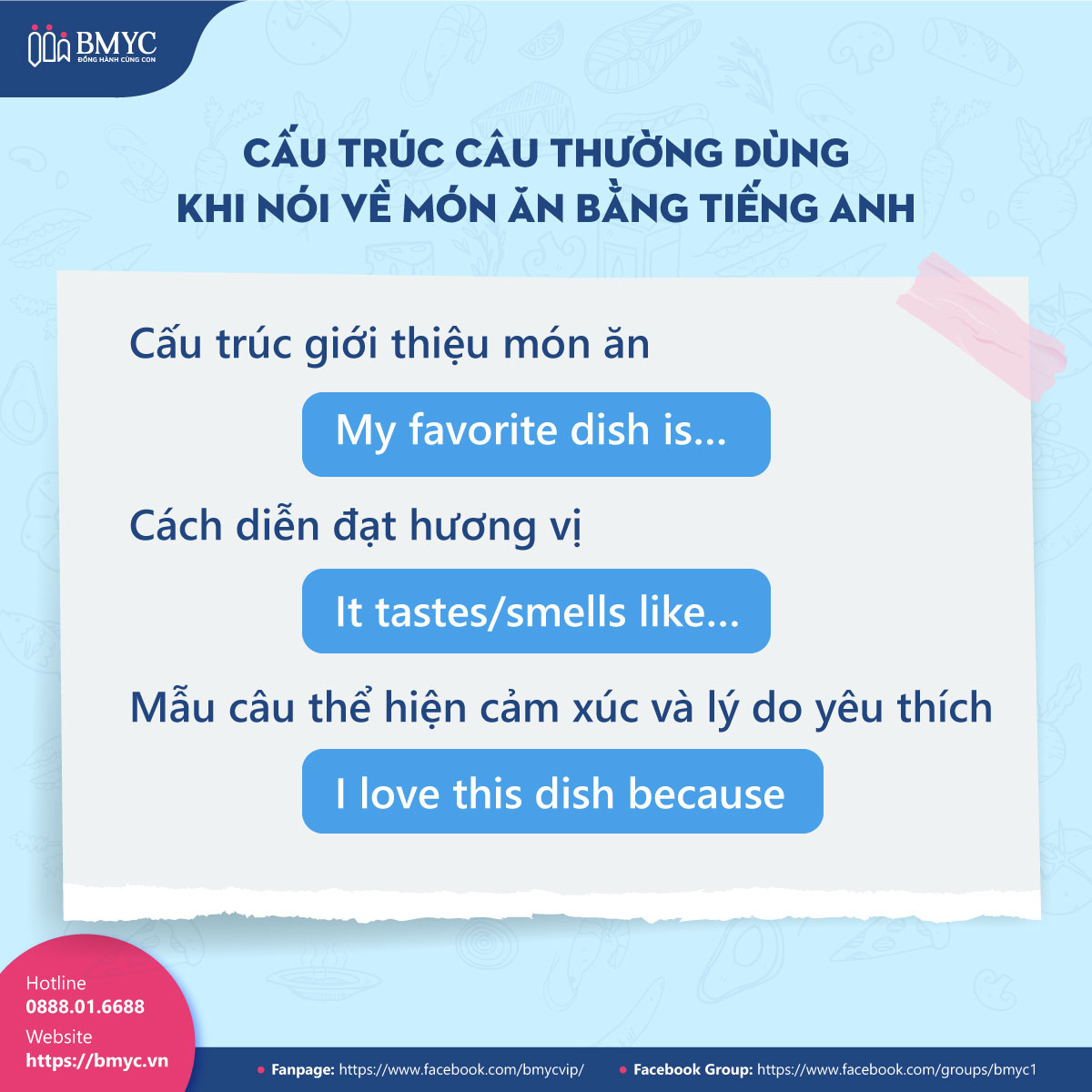
3.1 Cấu trúc giới thiệu món ăn (My favorite dish is…)
- My favorite dish is [tên món ăn] – “My favorite dish is Tom Yum Goong, a spicy Thai soup.”
- I’m particularly fond of [tên món ăn] – “I’m particularly fond of banh mi, a Vietnamese sandwich.”
- Nothing compares to [tên món ăn] when it comes to [tiêu chí] – “Nothing compares to my mother’s lasagna when it comes to comfort food.”
- If I had to choose one dish to eat for the rest of my life, it would be [tên món ăn] – “If I had to choose one dish to eat for the rest of my life, it would be sushi.”
- Among all the dishes I’ve tried, [tên món ăn] stands out as my absolute favorite – “Among all the dishes I’ve tried, pho stands out as my absolute favorite.”
- The dish that has captured my heart is [tên món ăn] – “The dish that has captured my heart is traditional French ratatouille.”
3.2 Cách diễn đạt hương vị (It tastes/smells like…)
- It has a [tính từ] taste/flavor – “It has a smoky flavor that lingers on your palate.”
- The dish tastes [tính từ] – “The dish tastes subtly sweet with hints of cinnamon.”
- It smells like [danh từ/cụm danh từ] – “It smells like a summer garden after a light rain.”
- The flavor profile includes [danh từ] – “The flavor profile includes notes of citrus and herbs.”
- It’s [tính từ] with a hint of [danh từ] – “It’s savory with a hint of sweetness from the caramelized onions.”
- The taste can best be described as [mô tả] – “The taste can best be described as a perfect balance between tangy and sweet.”
- When you take a bite, you’ll experience [cảm giác] – “When you take a bite, you’ll experience an explosion of contrasting flavors.”
3.3 Mẫu câu thể hiện cảm xúc và lý do yêu thích
- I love this dish because [lý do] – “I love this dish because it reminds me of my childhood vacations by the sea.”
- What makes this dish special to me is [lý do] – “What makes this dish special to me is the way it brings my entire family together.”
- I’m drawn to this dish for its [đặc điểm] – “I’m drawn to this dish for its complex flavors and cultural significance.”
- This dish holds a special place in my heart because [kỷ niệm] – “This dish holds a special place in my heart because my grandmother taught me how to make it.”
- Whenever I eat [tên món ăn], I feel [cảm xúc] – “Whenever I eat homemade bread, I feel an incredible sense of comfort and nostalgia.”
- The reason I can never resist [tên món ăn] is [lý do] – “The reason I can never resist chocolate soufflé is its irresistible combination of warm, gooey center and crisp exterior.”
4. Dàn ý viết đoạn văn về món ăn yêu thích theo 3 cấp độ
Việc xây dựng dàn ý hợp lý là yếu tố quan trọng để viết một đoạn văn nói về món ăn yêu thích bằng tiếng Anh rõ ràng và có tổ chức. Theo PGS.TS Nguyễn Hòa, chuyên gia ngôn ngữ học của Đại học Quốc gia Hà Nội, việc chuẩn bị dàn ý trước khi viết giúp tăng khả năng liên kết ý tưởng lên đến 40%.

4.1 Cấp độ A1–A2: Ngắn gọn, dễ hiểu
Dàn ý:
1. Giới thiệu món ăn yêu thích
- Tên món ăn
- Xuất xứ (nếu biết)
2. Mô tả đơn giản
- Thành phần chính
- Màu sắc/hình dáng
3. Lý do thích
- Hương vị
- Cảm giác khi ăn
4. Kết luận
- Tần suất ăn
- Khẳng định lại sở thích
Ví dụ:
My favorite food is pizza. It has cheese, tomato sauce, and many toppings on bread. I like pizza because it tastes delicious and smells good. The cheese is stretchy, and the crust is crunchy. I eat pizza once a week, usually on Friday nights with my family. It is definitely my favorite food.
4.2 Cấp độ B1–B2: Có thêm lý do & cảm xúc
Dàn ý:
1. Giới thiệu món ăn yêu thích
- Tên và xuất xứ
- Ý nghĩa văn hóa (nếu có)
2. Mô tả chi tiết
- Thành phần chính và phụ
- Cách chế biến
- Hương vị và kết cấu
3. Lý do yêu thích
- Cảm nhận cá nhân
- Kỷ niệm gắn liền
- So sánh với các món khác
4. Cảm xúc và trải nghiệm
- Cảm giác khi ăn
- Bối cảnh thường thưởng thức
5. Kết luận
- Tóm tắt lý do yêu thích
- Chia sẻ thêm thông tin thú vị
Ví dụ:
My favorite dish is Pad Thai, a popular street food from Thailand that has gained international recognition. This stir-fried noodle dish perfectly balances sweet, sour, and savory flavors, which is characteristic of Thai cuisine.
Pad Thai consists of rice noodles, scrambled eggs, tofu, bean sprouts, and either chicken, shrimp, or sometimes both. The sauce, which gives this dish its distinctive taste, is made from tamarind paste, fish sauce, brown sugar, and chili. The dish is typically garnished with crushed peanuts, lime wedges, and fresh cilantro.
I particularly love Pad Thai because of its complex flavor profile and interesting texture contrast. The chewy noodles, crunchy peanuts, and fresh bean sprouts create a delightful eating experience. Unlike many other noodle dishes, Pad Thai never feels heavy or greasy when prepared properly.
Whenever I eat Pad Thai, I’m reminded of my first trip to Bangkok, where I tried it from a small street vendor near Khao San Road. The cook prepared it right in front of me on a sizzling wok, and the aromatic scent filled the air. Now, I often make it at home for special occasions, though it never quite matches the authentic street version.
In conclusion, Pad Thai remains my all-time favorite dish for its perfect balance of flavors, textures, and the wonderful memories associated with it. It’s a dish that truly represents the art of balance in cooking.
4.3 Cấp độ C1 trở lên: Có kỷ niệm và mở rộng sáng tạo
Dàn ý:
1. Giới thiệu món ăn và hooks thu hút
- Câu mở đầu ấn tượng
- Tên món ăn và nguồn gốc lịch sử/văn hóa
2. Mô tả chuyên sâu
- Phân tích các thành phần
- Quá trình chế biến độc đáo
- Biến thể khu vực/địa phương
3. Phân tích cảm quan
- Hương vị phức tạp
- Kết cấu và cách thưởng thức
- Sự kết hợp của các thành phần
4. Kỷ niệm và ý nghĩa cá nhân
- Câu chuyện gắn liền với món ăn
- Tác động đến sở thích ẩm thực
- Liên hệ với các trải nghiệm cá nhân
5. Suy ngẫm văn hóa hoặc triết lý
- Ý nghĩa của món ăn trong văn hóa
- Suy nghĩ về ẩm thực và con người
6. Kết luận sâu sắc
- Tổng hợp cảm xúc và suy nghĩ
- Thông điệp hoặc bài học rút ra
Ví dụ:
The aroma of freshly baked sourdough bread wafting through the house is, perhaps, one of life’s most underrated luxuries. My favorite culinary creation, sourdough bread, transcends the mere classification of “food” and enters the realm of artistry and science—a perfect symphony of simplicity and complexity that has captivated humans for over 6,000 years.
This ancient bread begins with nothing more than flour, water, salt, and time—ingredients so basic yet capable of transformation that borders on alchemical. The magic lies in the wild yeast and lactobacilli that develop in the sourdough starter, a living ecosystem that bakers tenderly nurture like a cherished pet. Each starter carries its own unique microbial signature, influenced by the local environment and handling, which is why no two sourdough loaves ever taste exactly alike. The fermentation process breaks down complex carbohydrates and phytic acid, making the bread not only more digestible but also unlocking flavors that conventional bread could never achieve.
When sliced open, a properly made sourdough reveals an intricate network of irregular holes—what bakers affectionately call the “crumb”—encased in a crackling crust burnished to varying shades of mahogany and gold. The flavor profile defies simple description: tangy yet sweet, complex yet comforting, with notes that range from nutty to fruity depending on the flour used and fermentation time. The textural contrast between the chewy interior and shattering crust creates an eating experience that engages all senses.
My affinity for sourdough bread stems from more than its gustatory delight; it’s intertwined with memories of my grandfather, who maintained his starter through decades, including during wartime scarcity. I vividly recall watching his weathered hands coaxing the dough into shape, his movements deliberate yet intuitive. “Bread is patient,” he would say, “and so must be the baker.” When he passed away, his century-old starter became my most treasured inheritance—a living legacy that continues to produce bread for my family table.
There’s something profoundly philosophical about sourdough bread making. In our era of instant gratification, it demands patience and attention to subtle changes. It requires us to surrender control to natural processes and microscopic organisms. The bread reminds us that transformation—whether of dough or self—requires time and cannot be rushed. Each loaf becomes a meditation on patience, a practice in mindfulness, and a connection to generations of bakers who have performed these same rituals throughout human history.
In conclusion, my favorite food represents far more than sustenance; it embodies heritage, craftsmanship, science, and art in perfect balance. When I break bread with loved ones—that same distinctive tangy aroma filling the room—I’m not just sharing food but continuing a tradition that connects us across time and cultures. In a world of fleeting trends and processed convenience, sourdough bread stands as a delicious rebellion—a reminder that some things are worth the wait.
5. Mẫu đoạn văn nói về món ăn yêu thích bằng tiếng Anh theo chủ đề
Việc có nhiều đoạn văn nói về món ăn yêu thích bằng tiếng Anh theo các chủ đề khác nhau sẽ giúp bạn có thêm nguồn cảm hứng và học hỏi cách diễn đạt đa dạng. Theo khảo sát từ Cambridge English, 78% người học ngoại ngữ tiến bộ nhanh hơn khi được tiếp xúc với nhiều mẫu văn khác nhau trong cùng một chủ đề.
5.1 Món ăn truyền thống Việt Nam (phở, bún chả, bánh mì…)
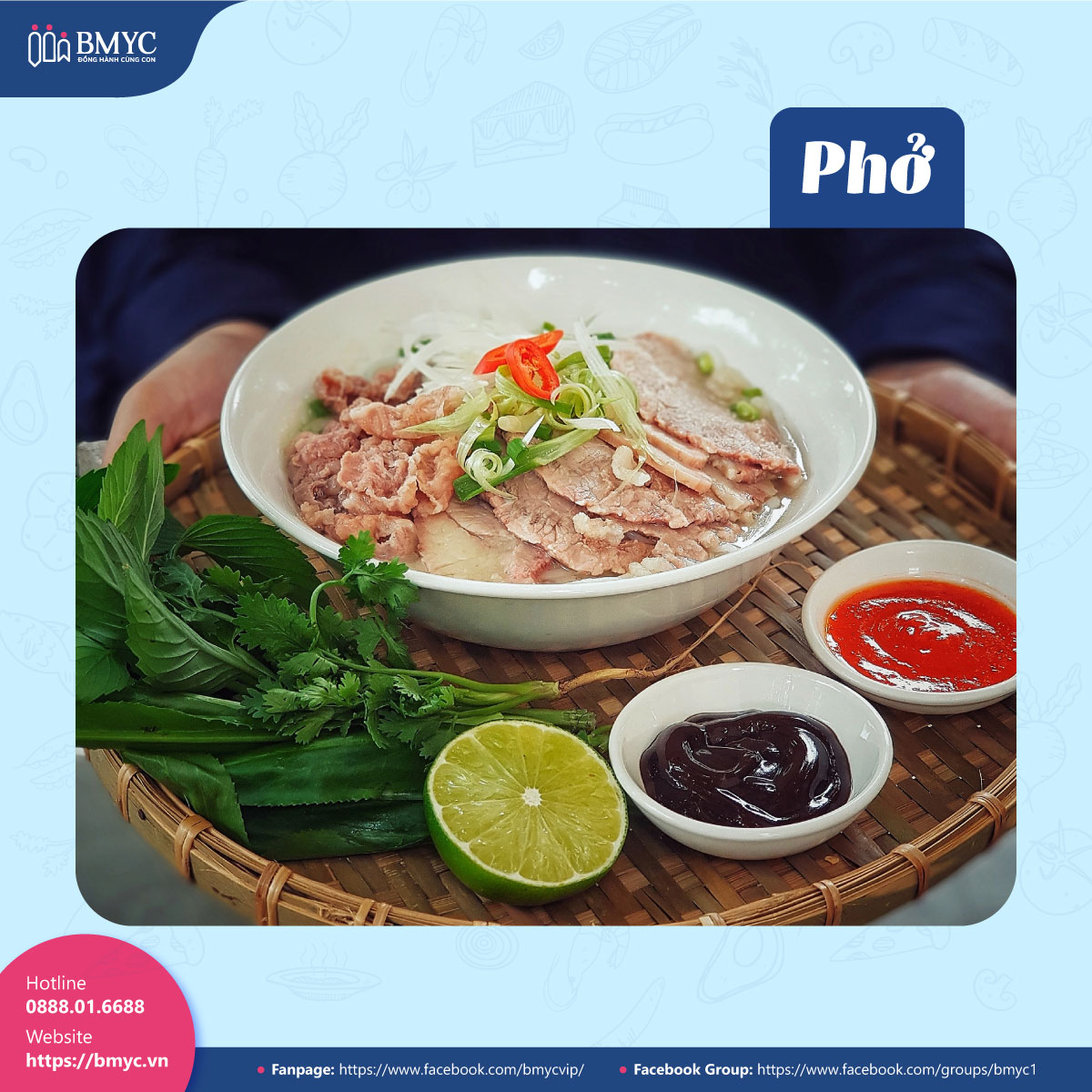
Ví dụ về Phở:
My favorite dish is Vietnamese pho, a culinary masterpiece that represents the soul of Vietnamese cuisine. This aromatic beef noodle soup originated in Northern Vietnam in the early 20th century and has since become Vietnam’s unofficial national dish, beloved both domestically and internationally.
Authentic pho consists of a crystal-clear yet deeply flavored broth made by simmering beef bones, oxtail, and spices like star anise, cinnamon, and cloves for many hours. The broth is then ladled over rice noodles and thinly sliced beef (either cooked or raw, which cooks in the hot broth). What elevates this dish to extraordinary heights is the accompaniment of fresh herbs and garnishes – Thai basil, cilantro, bean sprouts, lime wedges, and chili peppers – which diners add according to their preference.
I particularly cherish pho because of its remarkable balance of flavors and textures. The broth simultaneously delivers umami richness and delicate clarity, while the rice noodles provide a satisfying chewiness. The herbs contribute freshness that cuts through the richness, creating a harmonious eating experience that is both comforting and complex.
My fondness for pho is also deeply personal. My grandmother taught me that a good bowl of pho tells a story about the person who made it – their patience, attention to detail, and understanding of balance. Whenever I taste a truly exceptional bowl, I’m reminded of early mornings in Hanoi, where people gather at street stalls before dawn to enjoy this breakfast staple steaming in the morning mist.
Pho represents more than just delicious food to me; it embodies the Vietnamese philosophy of harmony between opposing elements – hot and cold, cooked and raw, rich and fresh. This magnificent dish will always hold a special place in my heart as both culinary perfection and a connection to my cultural heritage.
5.2 Món ăn nhanh (pizza, hamburger, fried chicken…)
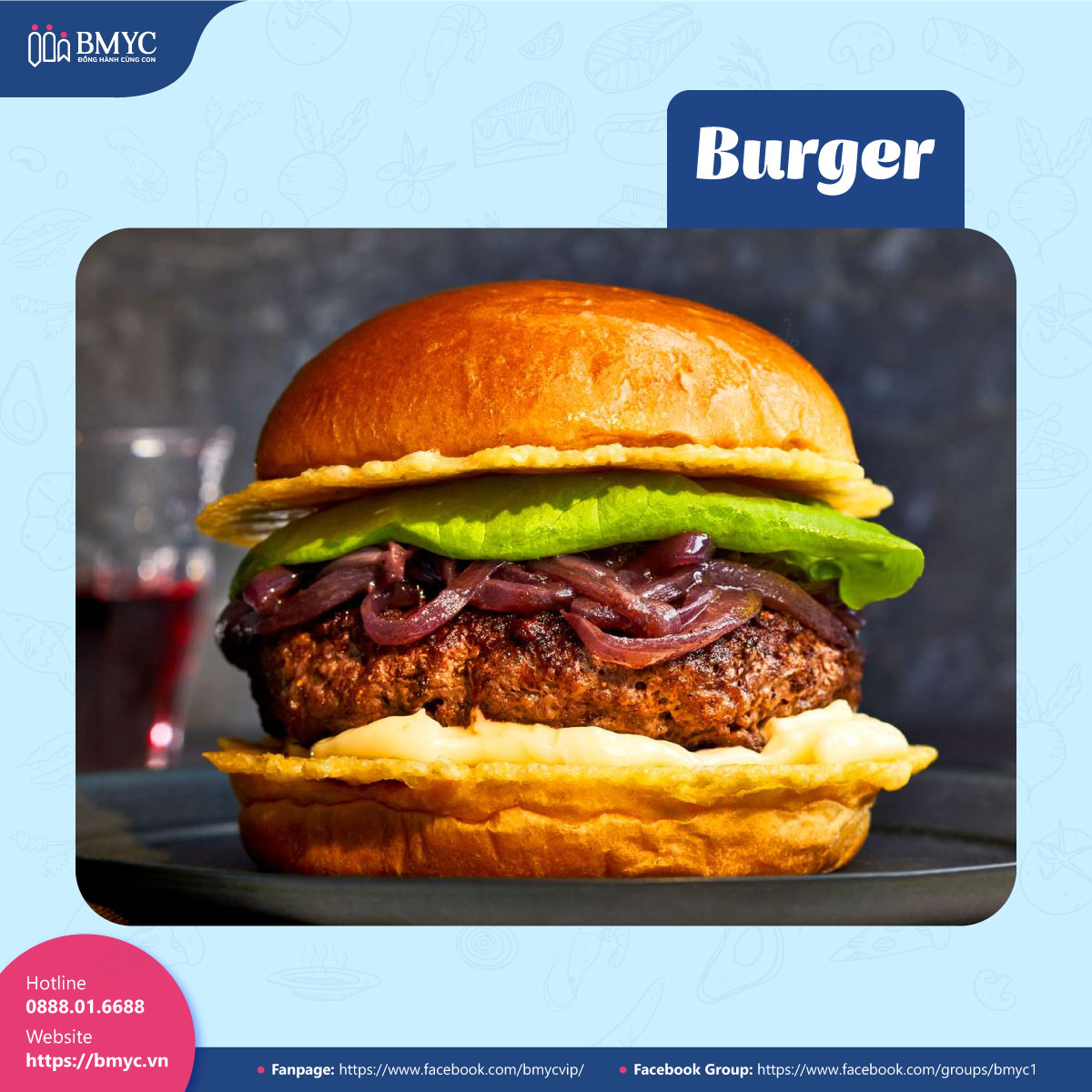
Ví dụ về Burger:
My favorite food is a well-crafted hamburger, which represents the pinnacle of comfort food with its perfect balance of flavors, textures, and versatility. While hamburgers have humble origins, allegedly named after Hamburg, Germany, they have evolved into an art form that transcends their fast-food reputation.
The ideal hamburger, in my opinion, starts with quality ground beef (preferably a blend of chuck, brisket, and short rib) formed into a patty that’s neither too compact nor too loose. When cooked to medium with a caramelized crust while maintaining juiciness inside, the patty becomes the foundation of this culinary marvel. The bun should be substantial enough to hold everything together yet soft enough to complement rather than compete with the fillings. A slight toasting adds structural integrity and a pleasant textural contrast.
What I find most appealing about hamburgers is how they engage all the senses: the sizzle as the patty hits the grill, the mouthwatering aroma of beef caramelizing, the visual appeal of layers revealed in cross-section, the textural symphony from the first bite, and of course, the harmonious blend of savory, sweet, tangy, and sometimes spicy flavors that unfold with each mouthful.
My appreciation for hamburgers deepened during my college years, when my friends and I would embark on weekend “burger quests” to find the best hamburger in the city. These adventures weren’t just about food; they became bonding experiences filled with debates about what constitutes hamburger perfection and laughter over messy, dripping bites. Even today, trying a new burger place with old friends brings back those carefree days.
Unlike more elaborate dishes, the hamburger is unpretentious yet infinitely customizable, reflecting both culinary democracy and personal expression. From classic American cheeseburgers to globally inspired variations with ingredients like kimchi or harissa, the hamburger serves as a canvas for creativity while remaining fundamentally recognizable. This beloved dish stands as testimony to how something seemingly simple can achieve gastronomic greatness when handled with care and imagination.
5.3 Món tráng miệng (chè, kem, bánh ngọt…)
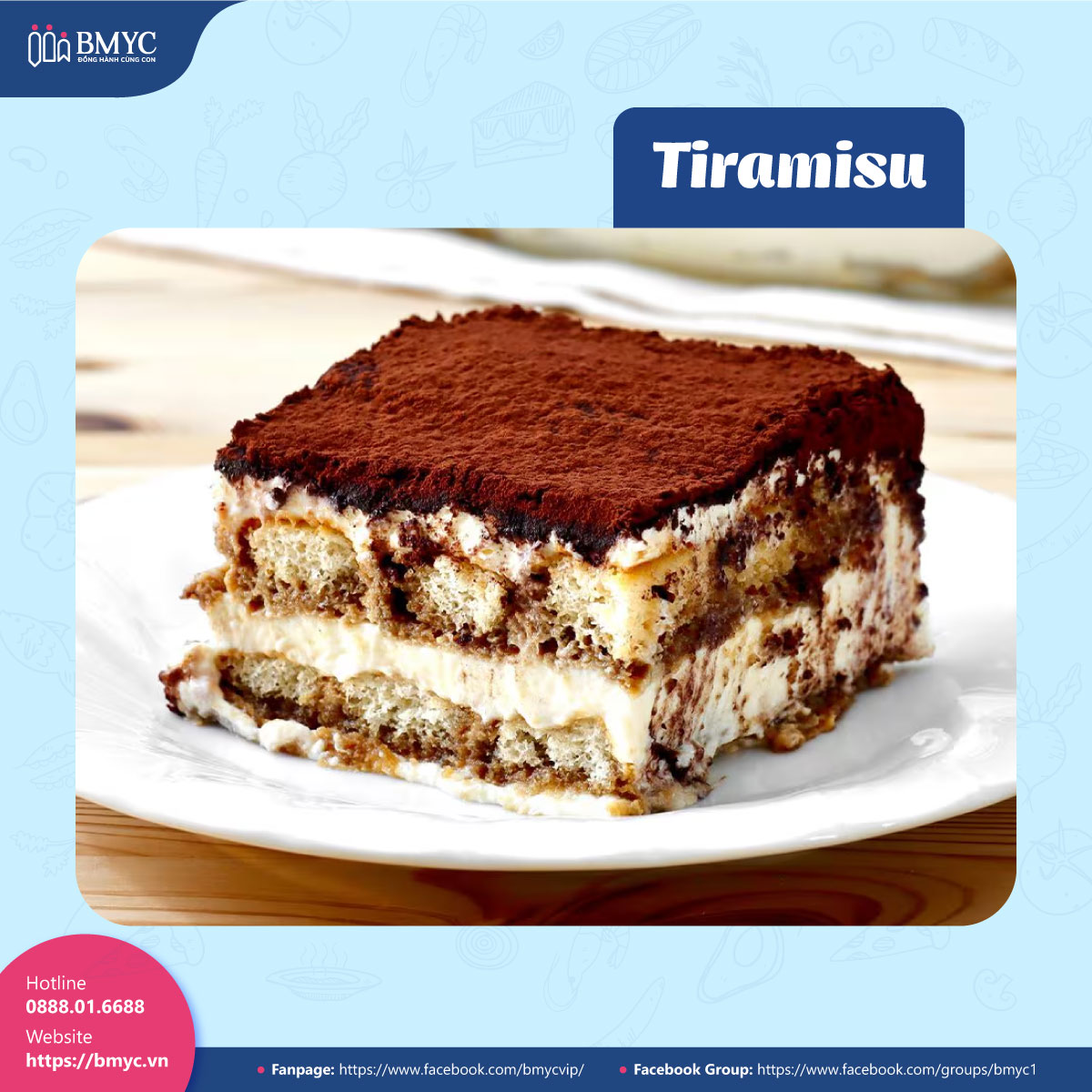
Ví dụ về Tiramisu:
My favorite dessert is tiramisu, an Italian masterpiece that perfectly balances bold coffee flavor with delicate creaminess. This iconic layered dessert, whose name poetically translates to “pick me up” or “lift me up” in Italian, originated in the Veneto region during the 1960s and has since captivated dessert enthusiasts worldwide.
Classic tiramisu features alternating layers of espresso-soaked ladyfinger biscuits and a velvety mixture of mascarpone cheese, eggs, and sugar, finished with a dusting of cocoa powder. Each component plays a crucial role in the dessert’s harmonious composition. The ladyfingers, once crisp, transform through their coffee bath into soft foundations that retain enough structure to support the airy mascarpone cream. The mascarpone mixture itself achieves a remarkable consistency—lighter than cheesecake yet more substantial than mousse—creating a luxurious mouthfeel that slowly dissolves on the tongue.
What I find most enchanting about tiramisu is its sophisticated flavor profile. The intensity of espresso provides a pleasant bitterness that counterbalances the sweet, rich mascarpone. This contrast creates a complex taste experience that evolves with each spoonful. Unlike overly sweet desserts that can become cloying after a few bites, tiramisu remains interesting throughout, with subtle notes of cocoa, vanilla, and sometimes marsala wine revealing themselves gradually.
My appreciation for tiramisu began during a memorable trip to Venice, where I tasted an authentic version at a small family-owned pasticceria. The elderly owner proudly explained that their recipe had remained unchanged for three generations. That first taste—the cloud-like texture giving way to intense coffee notes—created an indelible food memory that I’ve sought to recreate ever since. Though I’ve made tiramisu dozens of times at home, there’s always something slightly magical about the process of transformation as the components meld together during their rest in the refrigerator.
Beyond its deliciousness, tiramisu represents the Italian culinary philosophy of taking relatively simple ingredients and, through thoughtful combination and technique, elevating them into something greater than the sum of their parts. In this way, this beloved dessert exemplifies how truly exceptional food can transcend mere sustenance to become a form of cultural expression and artistry.
6. TỔNG KẾT
Bài viết trên đây sẽ hướng dẫn chi tiết cách viết đoạn văn nói về món ăn yêu thích bằng tiếng Anh với nhiều mẫu câu, từ vựng và cấu trúc đa dạng và phong phú.BMyC hi vọng bài viết sẽ giúp ích cho các bạn trong việc học tiếng Anh và mong muốn các bạn sẽ cùng đồng hành với BMyC trong tương lai.
Đừng để con bạn bỏ lỡ cơ hội giỏi tiếng Anh từ sớm! Tham gia ngay Group Bố Mẹ Yêu Con để được tư vấn phương pháp học tiếng Anh online cho bé phù hợp và xây dựng lộ trình học hiệu quả, giúp con tự tin chinh phục tương lai!
Xem thêm:
- 200+ từ vựng tiếng anh về món ăn Vệt Nam phổ biến nhất
- Tổng hợp 45+ món ăn ngày tết bằng tiếng Anh đầy đủ nhất